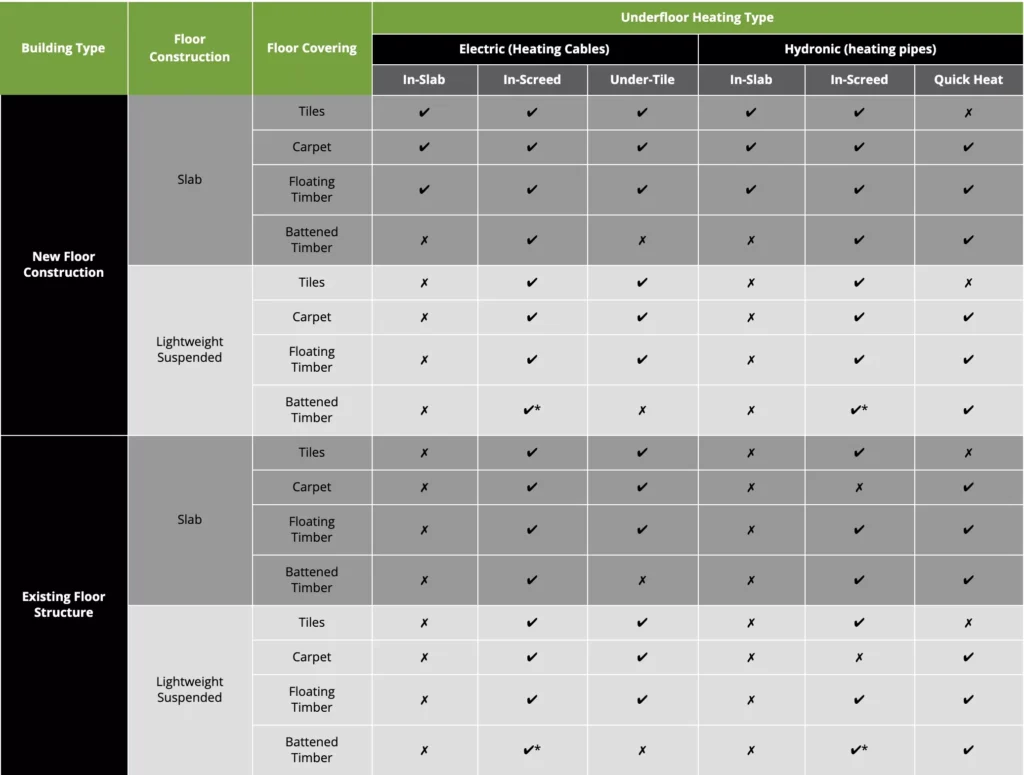Your cart is currently empty!
FAQ
Engineered Timber Flooring
Can I install timber flooring over the underfoot heating
With the right experience, moisture testing, understanding of the radiant heat system and knowledge about the wood flooring being used, contractors can make wood flooring over radiant heat work – even work extremely well.
The builder should be open to learning everything you can teach him about wood flooring and moisture and you should feel that the radiant heat installer, HVAC contractor, plumber and electrician are all competent and know what they’re doing, not experimenting with their first radiant heat job. You’ll also need to know exactly what kind of HVAC systems will be installed. By code, radiant-heated homes must have some kind of ventilation system, and they are often supplemented with a typical forced-air system that includes air conditioning.
There should also be systems in place to help stabilise humidity year-round. All of this, along with knowledge, will help to predict what kind of moisture swings the floor will experience.
Even the job site is manageable, it’s still critical to educate everyone involved, especially the homeowner, about wood flooring expansion and contraction, snd why they need to control the humidity levels in their home.
What products will be suitable for underfoot heating
1. Narrower widths
2. Engineered floors
3. Parquet
4. Dark Floors
5. Beveled edges
6. Dimensionally stable species

What is engineered timber flooring?
Engineered timber flooring is made up of a veneer of 2-6mm of natural hardwood which is glued to a backing timber layer(s). Once installed an engineered wood floor looks just like a solid timber floor but it is much more stable and has many additional benefits. Sometimes Engineered wood flooring is mistaken for laminate flooring, as the timber in some respects is ‘laminated’ to do backing or core layer. A laminate floor is artificial that imitates real timber whereas engineered timber flooring is the real deal.
What does pre-finished mean?
Pre-finished is a term used to describe flooring which has had finishing coatings applied in the factory as a part of the manufacturing process. Pre-finished flooring should not require any further finishing after installation.
What is the difference between herringbone and chevron?
Herringbone pieces overlap on the ends to create a weave-like pattern, whereas Chevron pieces meet together on the ends, creating a ‘V’ shape.
What is a lacquer?
Lacquer is a type of finish that is used to seal the pores of wood, acting as a protective layer. Lacquer finishes offer a long-lasting, durable and low-maintenance finish.
What is UV oil?
UV oil is a type of oil finish that absorbs into the pores of wood, and is hardened under UV light. UV oil finishes appear the same as natural oil but are typically more durable, although they still require periodic care and maintenance.
What do ‘brushed’ mean?
When the surface of timber has been brushed with wire, which scrapes away the softer parts of the wood grain and leaves the harder grain intact. This results in a texture that follows the wood’s natural grain pattern.
What is smoked timber?
Smoked (aka fumed) timber has been treated with a chemical which causes the wood colour to darken whilst increasing colour variation. It can also result in a change of colour tone of the wood.